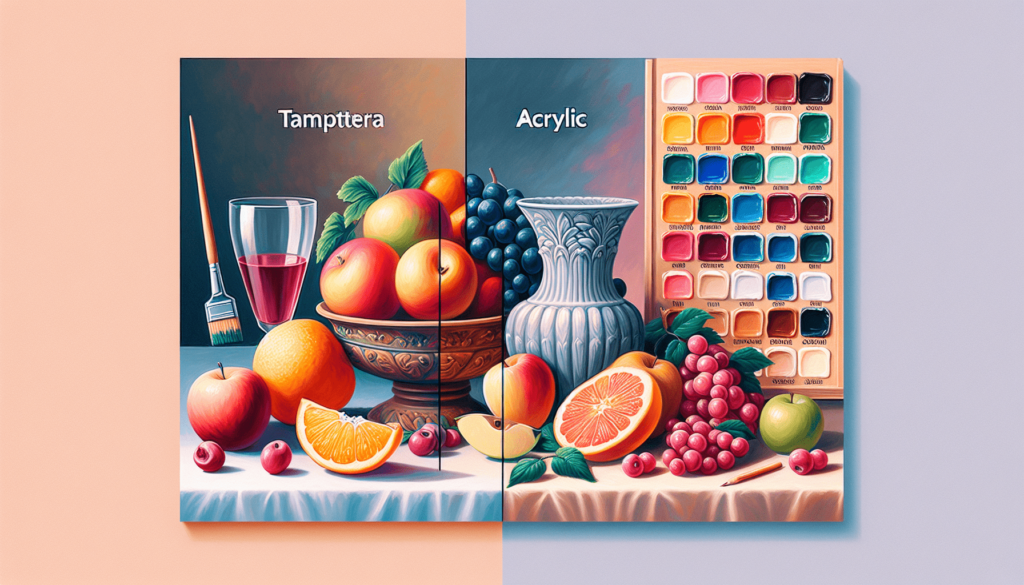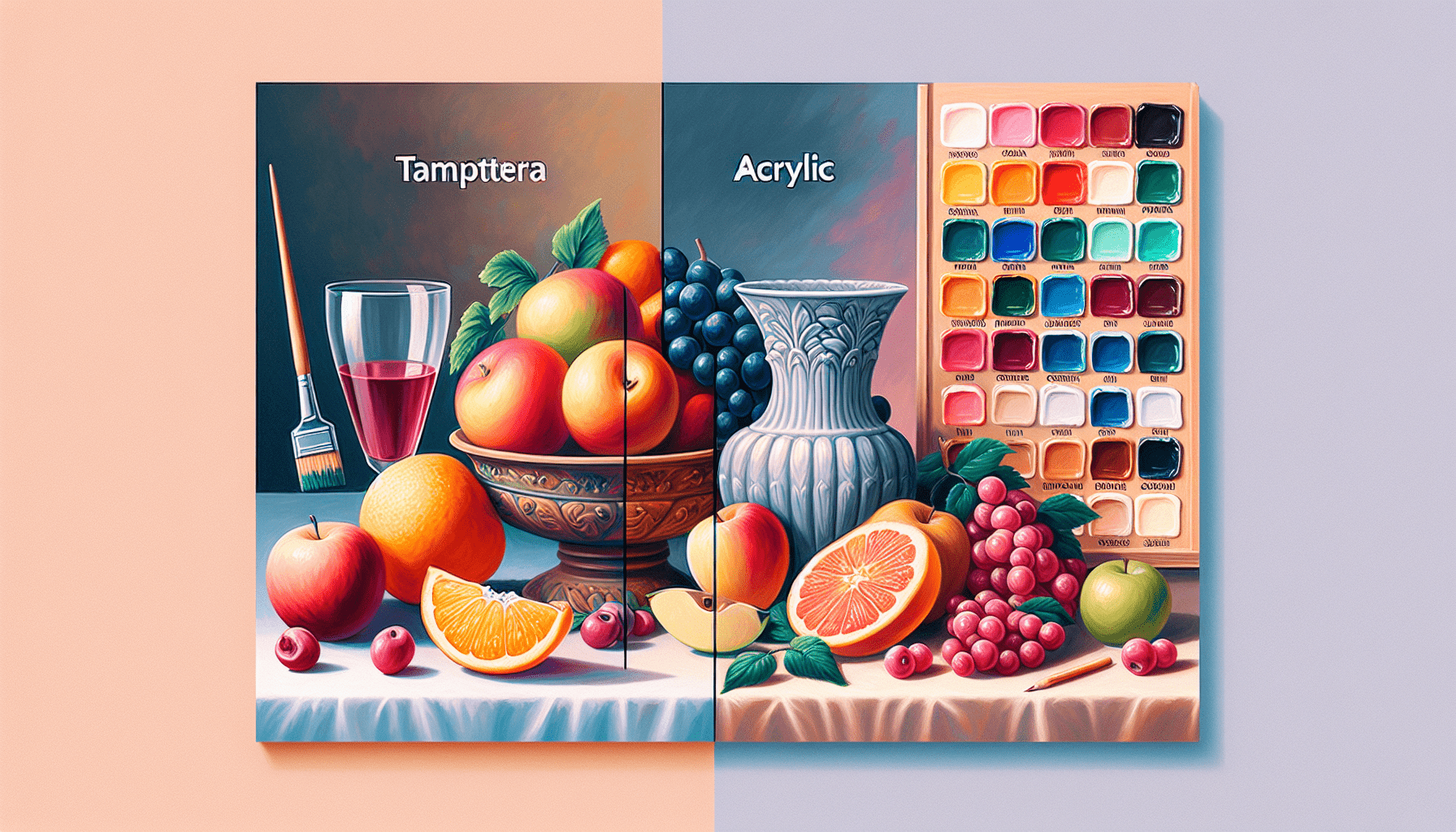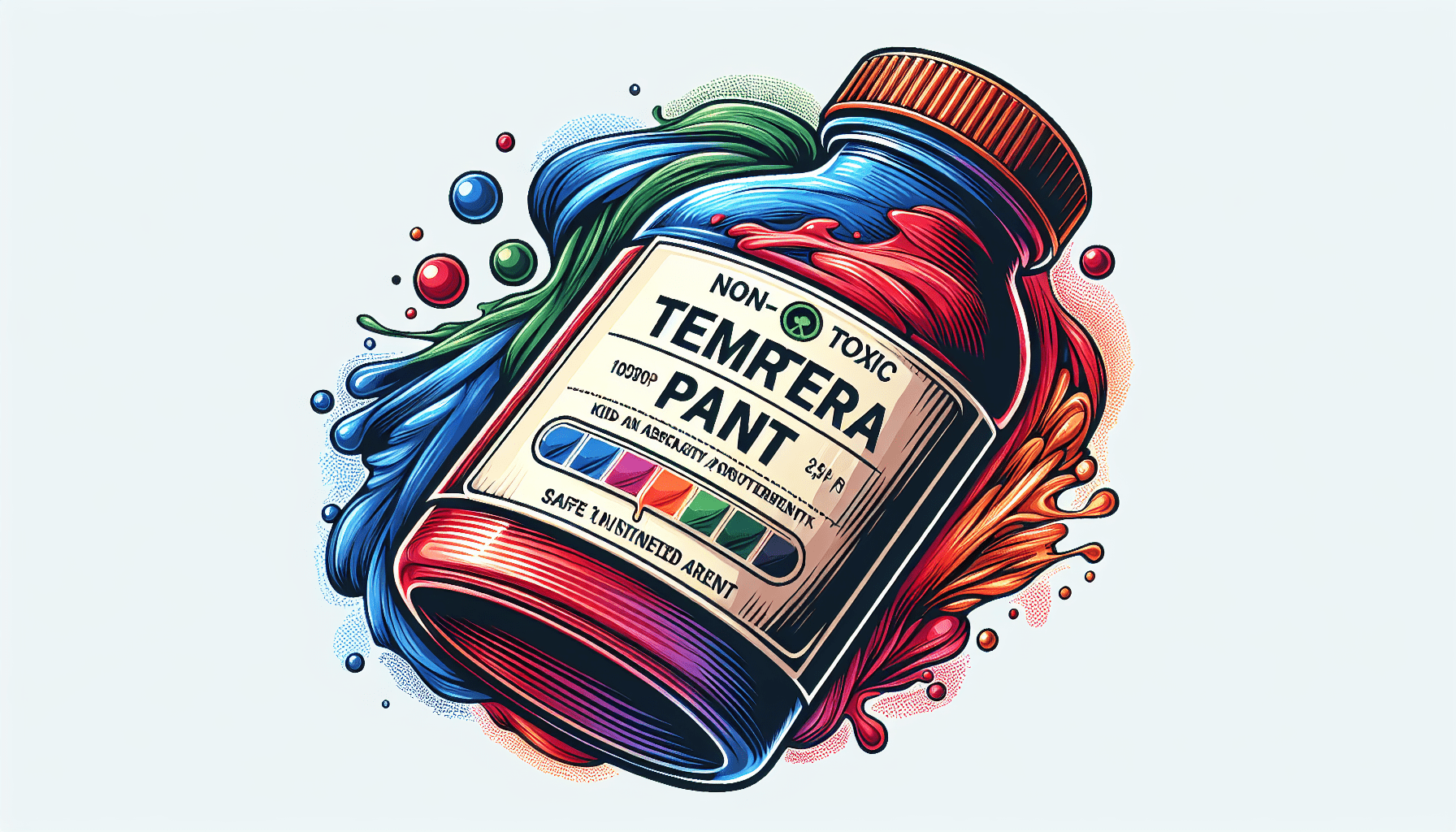This article aims to provide a clear and concise explanation of the differences between tempera paint and acrylic paint. By understanding the unique characteristics and properties of each medium, you will be able to make informed decisions when selecting the appropriate paint for your artistic endeavors. Whether you are a beginner seeking guidance or an experienced artist looking to expand your knowledge, this article will serve as a valuable resource in unraveling the distinctions between tempera paint and acrylic paint.

Definition of Tempera Paint
Tempera paint is a type of water-based paint that consists of pigments suspended in an egg yolk or water solution. It has been used for centuries and is known for its smooth and opaque finish.
Composition of Tempera Paint
Traditionally, tempera paint is made by mixing powdered pigments with a water-soluble binder, such as egg yolk. The egg yolk acts as a binding agent, holding the pigments together and creating a durable paint. However, modern versions of tempera paint may also use other binders, such as gum arabic or casein, to achieve similar results.
Characteristics of Tempera Paint
Tempera paint has several unique characteristics that make it stand out from other types of paint. Firstly, it dries quickly, allowing artists to layer colors and make corrections without waiting for long drying times. Secondly, it produces a matte finish, giving the paintings a more traditional and painterly look. Additionally, tempera paint is known for its vibrant and opaque colors, making it ideal for creating detailed and precise artwork.
Definition of Acrylic Paint
Acrylic paint is a water-based paint that contains acrylic polymers as its binding agent. It has gained popularity among artists since its introduction in the mid-20th century due to its versatility and ability to mimic other mediums such as oil and watercolor.
Composition of Acrylic Paint
Acrylic paint is composed of pigment particles suspended in an acrylic polymer emulsion. The acrylic polymer acts as both a binder and a vehicle, keeping the pigments together and allowing them to be spread evenly on a surface. Various additives, such as fillers and flow agents, are also included to improve the paint’s performance and handling properties.
Characteristics of Acrylic Paint
Acrylic paint offers several advantages over other types of paint. It dries quickly, allowing artists to work at a faster pace and make changes to their compositions. Once dried, acrylic paint forms a durable and water-resistant coating, making it suitable for a wide range of surfaces, both indoors and outdoors. Acrylic paint also provides a wide range of finishes, from glossy to matte, depending on the artist’s preference and the usage of additional mediums.
Historical Background
Origins of Tempera Paint
Tempera paint has a long history dating back to ancient civilizations. It was widely used in ancient Egypt, Greece, and Rome for various artistic purposes, including wall murals, manuscript illuminations, and panel paintings. Artists prized tempera paint for its vibrant and long-lasting colors.
Introduction of Acrylic Paint
Acrylic paint was first developed in the mid-20th century as an alternative to oil paints. Its invention revolutionized the art world, as it provided artists with a faster-drying and more versatile medium. Acrylic paint gained popularity due to its ability to be used on a wide range of surfaces and its excellent color retention properties.
Application and Use
Traditional Use of Tempera Paint
Tempera paint has been traditionally used for various art forms, including frescoes, icons, and illuminated manuscripts. Its smooth texture and opaque finish make it ideal for creating intricate details and precise lines. It is commonly applied with brushes, sponges, or even fingers, allowing artists to have full control over their artwork.
Versatility of Acrylic Paint
Acrylic paint offers artists a wide range of applications and techniques. It can be used on canvas, paper, wood, metal, and many other surfaces. Artists can employ various tools, such as brushes, palette knives, or even airbrushes, to apply acrylic paint. Its versatility allows artists to experiment with different styles and create both realistic and abstract artworks.

Mixing and Dilution
Mixing Options for Tempera Paint
Tempera paint can be mixed easily to create a vast array of colors. Artists can mix different pigments together to achieve custom shades and tones. Since tempera paint is water-based, it can also be diluted with water to create lighter values and transparent layers, similar to watercolor techniques.
Dilution Techniques for Acrylic Paint
Acrylic paint can be diluted with water to create more translucent and watery effects. However, unlike tempera paint, acrylic paint can also be diluted with various mediums, such as glazing medium or flow improver, to achieve different textures and finishes. Artists can also mix acrylic paints directly on the palette to create custom colors.
Drying Time and Durability
Drying Time of Tempera Paint
Tempera paint dries relatively quickly, usually within minutes to hours depending on the thickness of the application. This fast drying time allows artists to work in layers and make adjustments without smudging or blending the previous layers. However, it should be noted that tempera paint can become brittle over time, requiring proper care and framing to ensure its longevity.
Durability of Acrylic Paint
Acrylic paint dries quickly to a flexible and durable finish. Once dried, acrylic paint forms a waterproof and lightfast film that resists cracking, fading, and yellowing. This durability makes acrylic paint suitable for both indoor and outdoor applications, as well as for artworks that require transportation or handling.
Opacity and Layering
Opacity Levels in Tempera Paint
Tempera paint is known for its excellent opacity, allowing artists to achieve solid and bright colors. However, it can also be thinned with water to create semi-transparent layers, allowing underlying colors to show through. This versatility in opacity levels gives artists the freedom to create various effects and build up subtle details in their artwork.
Layering Capabilities of Acrylic Paint
Acrylic paint offers artists the ability to layer colors with ease. Since it dries quickly, artists can apply multiple layers of paint without waiting for extended drying times. This layering capability allows for different techniques, such as glazing or scumbling, where transparent or translucent layers are applied to create depth and luminosity in the artwork.
Color Range and Pigments
Available Color Range for Tempera Paint
Tempera paint offers a wide range of colors, including vibrant primary and secondary colors, as well as various earth tones. This broad spectrum allows artists to have a comprehensive palette to choose from and mix custom shades. Artists can also find specialty tempera paints, such as metallic or fluorescent colors, to add unique effects to their artwork.
Pigments Used in Acrylic Paint
Acrylic paint utilizes a range of pigments, including both organic and inorganic compounds, to create its color range. These pigments are finely ground to ensure even distribution and vibrant colors. Acrylic paint also offers a wide selection of colors, including metallics and iridescent options, to give artists a diverse range of possibilities.
Surface Compatibility
Suitability of Tempera Paint for Different Surfaces
Tempera paint adheres well to various surfaces, including wood, paper, and canvas. It can also be used on frescoes, plaster, and other porous surfaces. However, it is not recommended for surfaces that are exposed to excessive moisture or outdoors, as water sensitivity and potential fading may occur over time.
Adhesion of Acrylic Paint to Various Surfaces
Acrylic paint has excellent adhesion to a wide range of surfaces, including canvas, wood, metal, plastic, and fabric. It can also be used on non-traditional surfaces, such as glass or ceramics, with proper preparation or the use of specific primers. This versatility in surface compatibility makes acrylic paint a preferred choice for artists working in different mediums and on various surfaces.
Health and Safety Considerations
Safety Precautions for Using Tempera Paint
When using tempera paint, it is important to handle it with care and follow some safety precautions. Since tempera paint contains pigments, artists should avoid direct contact with eyes or ingestion of the paint. Adequate ventilation is also recommended when using large amounts of tempera paint or working in enclosed spaces to prevent inhalation of potentially harmful particles.
Health Risks Associated with Acrylic Paint
Acrylic paint is generally considered safe if used properly. However, artists should take precautions to minimize potential health risks. Some acrylic paints may contain toxic pigments or chemicals, so artists should avoid skin contact and ensure proper ventilation. It is also advisable to use non-toxic or low-odor acrylic paints for artists who are sensitive to fumes or have existing respiratory conditions.
In conclusion, both tempera paint and acrylic paint offer unique qualities and applications for artists. Tempera paint is recognized for its smooth texture, opacity, and historical significance, while acrylic paint provides artists with versatility, durability, and a wide range of color options. Understanding the composition, characteristics, and practical uses of each paint type allows artists to make informed choices and explore their creativity with confidence.



